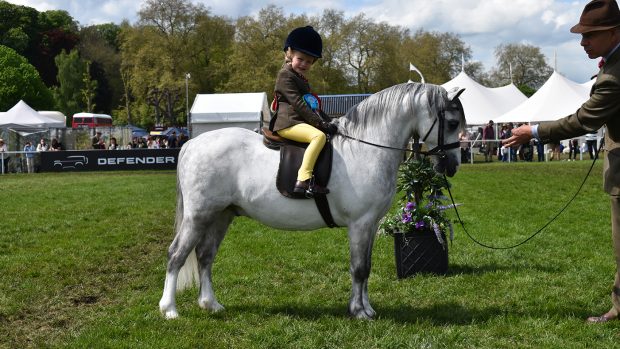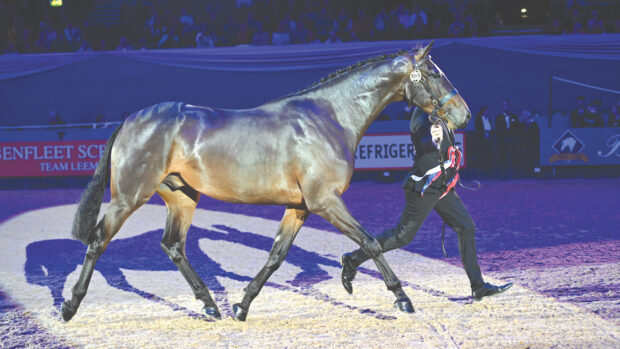Concerns over show ring etiquette can be off-putting for showing novices. So we have answered the questions that you thought were too obvious or embarrassing to ask
What colour and type of tack is correct for showing?
Generally, brown (havana) tack is considered correct for showing. There are variations in the type of tack used according to the class (cobs and hunters, for example, wear plain browbands; riding horses, hacks and show ponies/intermediate show riding types wear coloured browbands) but straight-cut saddles with neat black or brown numnahs are considered the norm to best show off the horse’s shoulder.
Working hunters would use a GP saddle or jumping saddle, again with a neat black or brown numnah, and martingales/breastplates are permitted. Large, square saddle pads or brightly coloured numnahs are not appropriate.
 Watch the video
Watch the videoHow do you know what kind of clothing to wear?
Again, what to wear for showing varies according to the class. Tweed jackets are commonly used in showing and there are a wide variety of colours, cloth weights and styles available. Tweed is correct for most classes, although at county shows lady riders would wear a blue or black jacket on a hack or during an evening performance (and may do so for riding horses). Jodhpurs or breeches should be fawn, cream or buff (not white as for showjumpers); children on show ponies often wear yellow or canary coloured jodhpurs. Plain, straight-topped brown or black leather riding boots with a garter strap are correct; children wear jodhpur boots until they move up to intermediate classes.
How do you know whether to plait your horse?
As a rule of thumb, show horses and ponies are plaited unless they are natives/traditionals or show cobs. The latter are hogged and natives/traditionals should be shown in their natural state according to the showing and/or breed society guidelines (rules vary on the amount of trimming that is permitted). Plaited tails are used for youngstock in-hand showing; horses and ponies under saddle have pulled tails unless they are natives/traditionals.
How do you know how long your individual show should be and what you should do for it?
Some judges will give competitors a set show — make sure you listen carefully to the instructions and follow them. In other cases, competitors are expected to show off their horses’ paces as appropriate to the class. As a rule of thumb, avoid complicated or over-long shows (a couple of minutes should be adequate); start with a square halt in front of the judge, followed by a short walk and trot, canter on both reins and an extension/gallop to finish, before coming back to a halt again in front of the judge. Bear in mind that higher-level shows will have a ride judge in most horse classes (including novice) so ensure your horse is used to other riders before expecting a ride judge to get on.
What to expect in a prize-giving?
Once the results have been announced, the final line-up of horses is expected to stand while the judges award the rosettes, sashes and any qualification cards/prize money. Most judges will hand rosettes to the rider, rather than attach them to the horse’s bridle. Once the prize-giving is complete, the winner leads off the line-up for a lap of honour. It’s worth spending some time teaching your horse to stand politely; the final result doesn’t stand until the rosettes have been awarded and it’s not unknown for horses to have lost their placings as a result of poor behaviour (even at the very highest level).
What is ringcraft?
You might have heard the term ‘ringcraft’ before and wondered what it meant. It’s part and parcel of the etiquette rules of the show ring, and is usually taken to mean showing off your horse or pony to its best advantage, without disadvantaging others. So, for example, most riders would wish to make sure they are in their own space during the “go round” (the initial walk, trot, canter on both reins and gallop of the whole class which allows the judge(s) to make their initial assessment). To do so, it’s permissible to circle away and find a better space, particularly if you are about to ride down the side of the ring where the judges are watching. Be aware, however, that it’s considered bad form (by other competitors and judges alike) to cut inside other competitors or generally allow your horse to crowd other horses in the ring.
You might also be interested in:

What do I wear in my horse or pony showing class? Read our dress code guide for show riders…

Want to impress in the show ring? Try one of these shaped showing numnahs
If you're looking to impress while showing, why not look at these shaped showing numnahs, designed specifically for the showring

Look and feel the part in one of these stylish tweed jackets

16 of the best competition breeches to wear in the saddle this season

Subscribe to Horse & Hound magazine today – and enjoy unlimited website access all year round
Horse & Hound magazine, out every Thursday, is packed with all the latest news and reports, as well as interviews, specials, nostalgia, vet and training advice. Find how you can enjoy the magazine delivered to your door every week, plus options to upgrade your subscription to access our online service that brings you breaking news and reports as well as other benefits.





